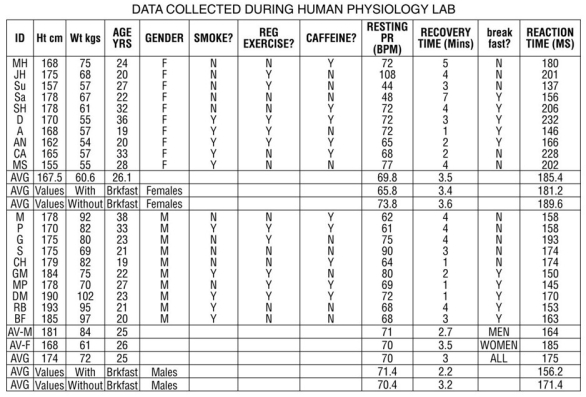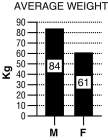Following is a table of data collected from one section of an 8 a.m.physiology lab.There were 20 students present, 10 men and 10 women.Information collected from the students included their height, weight, age, gender, and resting pulse rate.In addition, the students were surveyed to see if they smoked cigarettes, considered themselves "regular exercisers," if they had consumed caffeine the morning of the lab, and if they had eaten breakfast that day.A "y" or "n" (yes or no) was recorded to indicate their answers.Each student did "jumping jacks" for 5 minutes and recorded the time required to regain their resting heart rate, which is listed on the table as "recovery time." Finally, each student participated in an exercise designed to measure their reaction time (in milliseconds) in catching an object dropped by a lab partner according to specified criteria.Use this table to answer the following questions.Ignore statistical problems caused by small sample size, and so on.

Table 1.3

Figure 1.3
For these questions, the data were separated and analyzed by gender.
-Refer to Table 1.3.
A.Write a hypothesis regarding gender and recovery time.
B.What is the dependent variable? What is the independent variable?
C.Create a graph using the averages from the data table.Based on these data, what do you conclude?
Definitions:
Macrophages
A type of white blood cell that engulfs and digests cellular debris, foreign substances, microbes, and cancer cells in a process called phagocytosis.
Lymph Nodes
Small, bean-shaped structures that produce and store cells that help fight infection and disease.
Bacteria
Microscopic, single-celled organisms found in diverse environments, capable of causing disease or contributing to health.
White Pulp
Part of the spleen consisting of lymphatic nodules and diffuse lymphatic tissue; associated with arteries.
Q17: A fatty acid that contains three double
Q18: Which of the following statements is true
Q29: Honey should never be fed to children
Q31: List all of the errors in Figure
Q45: Peroxisomes<br>A) use an enzyme to destroy H₂O₂
Q47: Income level in the United States is
Q80: _ are activities that specifically increase muscle
Q84: Transcription factors are proteins whose binding to
Q97: Activation energy is<br>A) the energy lost or
Q111: An ion has gained or lost<br>A) a